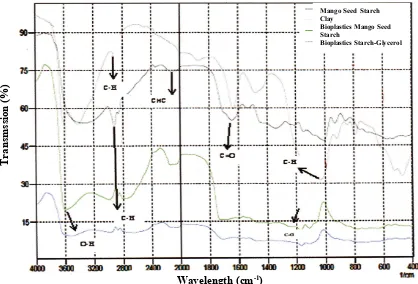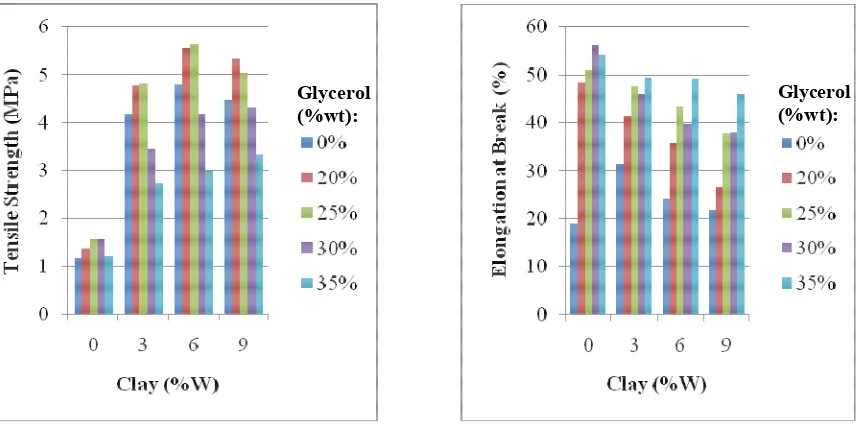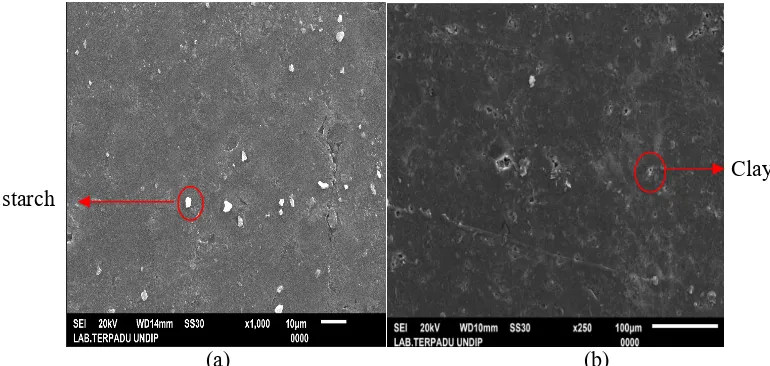IOP Conference Series: Materials Science and Engineering
PAPER • OPEN ACCESS
Utilization of mango seed starch in manufacture of bioplastic reinforced
with microparticle clay using glycerol as plasticizer
To cite this article: Maulida et al 2018 IOP Conf. Ser.: Mater. Sci. Eng.309 012068
View the article online for updates and enhancements.
1234567890‘’“”
TALENTA-CEST 2017 IOP Publishing
IOP Conf. Series: Materials Science and Engineering 309 (2018) 012068 doi:10.1088/1757-899X/309/1/012068
Utilization of mango seed starch in manufacture of bioplastic
reinforced with microparticle clay using glycerol as plasticizer
Maulida*1, T Kartika1, M B Harahap2 and M H S Ginting1
1Department of Chemical Engineering, University of North Sumatera, Medan,
Indonesia
2Department of Physics, State University of Medan, Medan, Indonesia
*E-mail: [email protected]
Abstract. Bioplastics are plastics that can be used just like conventional plastics but will disintegrate by the activity of microorganisms into water and carbon dioxide. Starch is a natural polymer material that can used for bioplastic production. The addition of reinforcing particles has been shown to improve the mechanical properties of bioplastics. The aim of this research is to know the potency of mango seed starch and microparticle clay as filler and glycerol concentration as plasticizer on tensile strength and elongation at break, functional group (FTIR) and surface morphology (SEM). In this study used mango seed starch size of 5 grams, with the variation of clay filler mass of 0; 3; 6 and nine wt%, while the mass of glycerol with a variation of 0; 20; 25; 30; And 35% wt. The heating temperature of the bioplastics
solution used was 80.53 0C. The resulting bioplastics was analyzed for their physical and
chemical properties, including FTIR, SEM, tensile strength, elongation at break. The FTIR analysis shows that no new functional groups was formed. From the analysis of mango starch content obtained 62.82%, 44.0% amylopectin content, amylose content 14.82%, and water content 12.65%. In this study obtained bioplastics with the best conditions on the use of 6% clay and 25% glycerol, with a tensile strength of 5.657MPa, percent elongation at breakup 43.431%.
1. Introduction
2
1234567890‘’“”
TALENTA-CEST 2017 IOP Publishing
IOP Conf. Series: Materials Science and Engineering 309 (2018) 012068 doi:10.1088/1757-899X/309/1/012068
polysaccharides (e.g. starch, cellulose, chitin, and lignin), proteins (e.g. gelatine, casein and wheat gluten) and lipids (e.g. plant oils and animals fats) [1]. In Indonesia, Mango production in Indonesia is fluctuating but tends to be high every year. There are still many mango seeds that are just left alone, so it only becomes a waste that pollutes the environment. The seed contains macromolecule reserves in large quantities and distinctive and has a starch content that can be utilized and is not a substitute for staple food. Trash of mango seeds that have not been utilized to the maximum this will result in an economic value. Also, mango seeds have a high enough starch content that potentially as an alternative substitute material in the manufacture of bioplastics. Amylose levels in mango seeds are expected to provide optimal mechanical properties, and amylopectin levels provide optimum stickiness [5]. In this study, the fillers used were organic clay with the size of microparticles which were then combined with mango seed starch as the matrix for bioplastic formation was biodegradable and had better mechanical properties. The addition of plasticizers or plasticizers into biodegradable film blends is necessary to overcome the fragility of films caused by high intermolecular forces [6].
Utilization of organic waste such as mango seeds for production of starch based bioplastic can help reduce the environmental damages that are caused by conventional plastics. Higher value bioplastics can be obtained by improving their properties with the most abundant and biodegradable reinforcing filler like cellulose. The goal of this work is to study the properties of bioplastics from agriculture waste. Effect of reinforcement fillers and plasticizers on bioplastics are also examined.
2. Materials and Methods
2.1. Materials
Starch derived from mango seeds was obtained from juice traders in Medan, clay with particle size 10.813 µm, and glycerol 99% was obtained from Rudang Jaya Medan.
2.2. Preparation Starch of Mango Seed
Mango seeds (100 gram) obtained from the waste container at local juice traders was washed with clean water before shredded to small pieces. The shredded mango seeds were later peeled and placed in mixing blender and soaked in water for about 100 ml. After mixing process, starch slurry was filtered and later placed in the tank for settling that took at least 30 minutes. Starch sediment was separated from the slurry and then washed again with distilled water. After the second settling, starch sediment was dried using an oven with temperature ±60 oC for removal of free water. Starch was
sieved with strainer 100 mesh/inch for better homogeneous size.
2.3. Bioplastic Preparation
A solution containing 0, 3, 6 and 9% wt/wt of fillers to starch was prepared by dispersing 100 ml distilled water and glycerol with concentration varied from 0, 20, 25, 30, and 35% wt/v of plasticizer to starch. The solution was placed into ultrasonic homogenizer KUDOS tank and processed for about 50 minutes. After ultrasonication, the solution was removed from the tank. Starch (5 gram) was added to the solution and heated using hot plate while stirred until it gelatinized (80.53 oC). After mixing, the
solution was cast onto flat and dried with temperature 60 oC for 24 hours. Once set, bioplastic was
cooled to ambient temperature before peeled off the flat.
2.4. Bioplastic Characterizations
2.4.1. Tensile Strength and Elongation at Break.
1234567890‘’“”
TALENTA-CEST 2017 IOP Publishing
IOP Conf. Series: Materials Science and Engineering 309 (2018) 012068 doi:10.1088/1757-899X/309/1/012068
2.4.2. Density.
The density of bioplastic was investigated by the standard of ASTM D792-91 on film with size approximately 5x5 cm. The film’s mass was measured using analytical balance. Density was calculated as follows :
Density
)
(cm
volume
(gram)
mass
3
(1)2.4.3. Water Uptake.
Water uptake was investigated by cutting film with size approximately 2x2 cm and then weighed the mass. The film was put into a container filled with distilled water for 24 hours. After immersion in water, the film was removed from the water and weighed to measure the wet weight. Water uptake was calculated as follows :
Water uptake
100
wet weight
dry weight
-wet weight
x
(2)2.4.4. Fourier Transform Infrared Spectroscopy (FT-IR).
Functional groups of bioplastics were analyzed by using IR Prestige-21 Shimadzu. The analysis using FT-IR represented spectrum data in graphic and wave numbers of each data that provided functional groups of bioplastics.
3. Results
3.1 The Result Starch Extraction from Mango Seed
In this study, the raw materials for bioplastics are starch extracted from mango seeds. Mango seeds obtained from juice traders located at the Pembangunan and Padang Bulan, Medan. The resulting starch grayish powder form with a particle size ± 100 mesh. The results starch extraction from the mango seeds yield of starch obtained by 43.2 %, which of 100 g dried starch mango seeds gained as much as 43.2 g and then further analysis of starch obtained.
(a) (b)
4
1234567890‘’“”
TALENTA-CEST 2017 IOP Publishing
IOP Conf. Series: Materials Science and Engineering 309 (2018) 012068 doi:10.1088/1757-899X/309/1/012068
3.2 Fourier Transform Infrared Spectroscopy (FT-IR)
Based on Fig. 7, the bioplastic starch of mango seed with glycerol plasticizer generated several peaks of wave numbers in each range of region. There is a peak of the wave number 3527.02 cm-1 to 2677.20
cm-1. The peak corresponds to the absorption caused by the C-H bond (type alkane compound), and
OH (type of phenol compound, hydrogen bonding alcohol). At peak with wave numbers 2140.99 cm-1
and 2059.98 cm-1, corresponds to the absorption caused by the triple bonds of C≡C (alkaline type
compounds). At the peak with the wave numbers 1948.10 cm-1 and 1550.77 cm-1, corresponding to the
absorption caused by the bonding C = O (a type of aldehyde, ketone, carboxylic acid, esters) and C = C (a type of alkene compound). At peak with wave numbers of 1477.47 cm-1 to 459.06 cm-1,
corresponds to absorption caused by the C-H bond (alkane type compound), and C-O (a type of alcohol, carboxylic acid, ester).
Bioplastic mango starch starch has a functional group which is a combination of specific functional groups contained in its constituent components such as C-H, O-H, C-O, C≡C, C = O, and C = C. The wavelength of the functional group OH in clay differs from the bioplastic starch of mango seed with the addition of glycerol plasticizer wherein the addition of glycerol causes the functional group OH to shift with wave length 3622.32 cm-1 to 3522.02 cm-1. It identifies that there is a process of forming
new bonds between matrix mango starch and glycerol to weaken the OH bond on the matrix of mango seed starch. In bioplastics with the addition of glycerol, the C-O and OH groups form a random carbon chain, thus causing the sample to become more elastic [12]. Chemical interactions are reflected by changes in the characteristics of the absorption peak spectrum after mixing of two or more matrix intermediates with added chemicals such as clay and glycerol [15].
Figure 2. FTIR specs of mango seeds starch, clay, pure starch bioplastic, starch/clay/glycerol bioplastic and starch/glycerol bioplastic
Wavelength (cm-1)
T
ra
n
sm
ss
io
n
(
%
)
Mango Seed Starch Clay
Bioplastics Mango Seed Starch
1234567890‘’“”
TALENTA-CEST 2017 IOP Publishing
IOP Conf. Series: Materials Science and Engineering 309 (2018) 012068 doi:10.1088/1757-899X/309/1/012068
3.3 Tensile Strength and Elongation at Break
In Fig. 3 and four can be seen the effect of adding clay fillers and glycerol plasticizers to tensile strength and elongation at breaks from bioplastics. The highest bioplastic tensile strength value was obtained also of 3% clay filler and 30% glycerol plasticizer with 5.657 MPa value. For the elongation value at the highest breakup bioplastic was obtained by the addition of 6% clay filler with the value of 47.553%. While also of glycerol elongation value at breakup bioplastic at concentration 35% glycerol with value 49.139%.
Figure 3. Tensile strength of starch based bioplastic reinforced with clay sing glycerol as the plasticizer.
Figure 4. Elongation at break of starch based bioplastic reinforced clay using clay as the plasticizer.
The influence of the addition of organic clay causes more hydrogen bonds in the biocomposite so that the chemical bonds are stronger and harder to break because they require a large amount of energy to break the bond [10]. While the percentage elongation is inversely proportional to the addition of natural clay. Where the natural addition of clay, causing percentage elongation decreased. This is due to the decreasing intermolecular bonding distance [11]. Clay has a micron-size surface area large enough to be able to interact effectively with the polymer matrix at low concentrations (5-8%). As a result, polymer clay showed an increase in modulus, thermal stability, and barrier properties without an increase in density and loss of optical properties [7].
Also, the high mass of clay filler can contribute to a slowdown in the interaction between molecules of starch bioplastics. This leads to the development of bioplastic structures becoming heterogeneous and the results being discontinuities [10]. With the addition of glycerol to the plasticizer, plasticizer molecules in bioplastics located between biopolymer bonding chain and be able to interact by forming hydrogen bonds in the bond between the polymer chains, causing interactions between the molecules of biopolymers have become less and may cause a decrease in biocomposite material stiffness. This is due to the increased speed of viscoelastic response and molecular mobility of the polymer chain [6]. The addition of plasticizers serves as a conduit on the elastic properties of bioplastics, so more plasticizer provided will increase the value of the plastic extension [12]. The plasticizer can reduce internal hydrogen bonds of molecules and lead to the weakening of the intermolecular attractive force adjacent polymer chains, thereby reducing the tensile breaking. The plasticizer can reduce internal hydrogen bonds of molecules and lead to the weakening of the
Glycerol (%wt):
6
1234567890‘’“”
TALENTA-CEST 2017 IOP Publishing
IOP Conf. Series: Materials Science and Engineering 309 (2018) 012068 doi:10.1088/1757-899X/309/1/012068
intermolecular attractive force adjacent polymer chains, thereby reducing the tensile breaking [13]. Based on this, it can be seen that elongation percentage is inversely proportional to tensile strength.
3.4 Results Analysis Morphological Characteristics Fault Bioplastics Starch Extraction Mango Seeds with Clay as Filler and Plasticizers Glycerol
Characteristics of fracture surface morphology are shown by analysis Scanning Electron Microscopy (SEM). Presented below are the characteristics of the results fracture morphology analysis bioplastics with the composition of the starch content of skin 5 grams of mango seeds, clay 6 % and 25 % glyserol at 1000x magnification. Characteristics SEM morphology analysis carried out in the laboratory of SEM, University of Diponegoro.
(a) (b)
Figure 5. Morphology Analysis Report Fault (a) Bioplastics Mango Seeds Starch and (b) Bioplastics from Mango Seeds Starch With Microparticles Clay as Filler and
Glycerol Plasticizer in Magnification 1000x
From Figure 5 it can be seen analysis fracture morphology, strength testing. The attraction of bioplastics. On the results of SEM analysis of mango seeds, starch bioplastics without filler microparticle clay and glycerol (Figure 5 (a)) shows are clumps of insoluble mango seed starch during plastic film making. It identifies that the starch in the matrix is poorly dissolved but is spread fairly evenly. The lack of sufficiently strong power in the heating and stirring process between the filler and the starch matrix is likely to cause the starch blob not fully dissolved properly. If there is a sufficiently strong force such as good agitation in the blending process at gelatinization temperature and glass transition will easily incorporate insoluble starch particles resulting in better distribution [7].
While at bioplastics mango seeds starch with microparticle clay and glycerol (Figure 5 (b)) SEM analysis results show white spots that are clay microparticle fillers and describe the clay particle size distribution. The above results show a fairly uniform dispersion of clay fillers into the matrix. The uniform dispersion shown from the SEM results shows that there is good adhesion between the micro-sized filler and the matrix. By the research Azizi et al. (2014) which states that clay films in matrices are uniformly dispersed, and the uniform distribution of micro-filler in matrices plays an important role in improving mechanical properties. The ultrasonic process of clay microparticles is intended to produce materials with unusual properties, which lead to the formation of larger particle surfaces, smaller particle size [8]. On the surface of the bioplastic, morphology does not show any empty fraction. This is due to the influence of microparticle-sized clay fillers so that the structure is more compact. [9]. From the above SEM analysis it can be concluded that the addition of clay microparticles dispersed well enough in the starch matrix is indicated by the optimum result of bioplastic mechanical characteristics with tensile strength value 5.657 MPa, percent extension at break off 43.431%, density 1.315 gr / cm3 and percent Water absorption 32.282%.
starch
1234567890‘’“”
TALENTA-CEST 2017 IOP Publishing
IOP Conf. Series: Materials Science and Engineering 309 (2018) 012068 doi:10.1088/1757-899X/309/1/012068
4. Conclusion
The mango seeds starch/Clay bioplastics increased in tensile strength from 1,567 MPa for pure starch bioplastic to 5.797 MPa. Contrary to tensile strength, a decrease in elongation at break was reported. The improvement in bioplastics with reinforcing clay could be attributed to the strong hydrogen bond between hydroxyl groups of the interface of both clay fillers and starch matrix. This formation is also influenced by the percolation mechanism. The density of bioplastics increased as clay content increased. Furthermore, an addition of clay content decreased water uptake of bioplastics. The incorporation of clay particles into starch matrix resulted in agglomerates that caused deflections in bioplastics. FT-IR spectra provided information about hydrogen bond through its characteristic peak. Bioplastic with the highest tensile strength assumed to have better characteristics than the other bioplastics was found at clay content 6% and 25% glycerol.
Acknowledgments
The authors gratefully acknowledge that the present research is supported by the University of Sumatera Utara through Non-PNBP funds by the talent research contract 2017.
Referrences
[1] Song J H, Murphy R J, Narayan R, Davies G B H 2009 Phil. Trans. R. Soc. B364 2127–39 [2] Reddy L, Reddy S, Gupta A 2013 IJETAE3 76–81
[3] Jain R, Tiwari A 2015 J Environ Health Sci Eng13 [4] Mose B R, Maranga S M 2011 J Mat Sci Eng 1 239-245
[5] Septiosari A, Latifah E K 2014 Indonesian Journal Of Chemical Science
[6] Maulida, Siagian M, Tarigan P 2016 Journal of Physics: Conference Series710 012012
[7] Nugroho A F 2012 Sintesis Bioplastik dari Pati Ubi Jalar Menggunakan Penguat Logam ZnO dan Penguat Alami Clay, Universitas Indonesia, Depok
[8] Widiyana K 2011 Penumbuhan Nanopartikel Seng Oksida (Zno)Yang Disintesis Dengan Metode Sonokimia Dan Pemanfaatannya Sebagai Tinta, Pengaman, Jurusan Kimia, Fakultas Matematika Dan Ilmu Pengetahuan Alam, Universitas Negeri Semarang, Semarang
[9] Kittiphoom S 2012 International Food Research Journal 4 1325.1335.
[10] Dani M, Parikin A H, Ismoyo A, Fisli S, Sugiyantoro S 2003 Karakterisasi Sifat Termal, Struktur, Kristal, Dan Warna Produk Bakar Clay-Sindanglaut. Poslitbang IPTEK Bahan Batan. Serpong
[11] Krisna D D A 2011 Pengaruh Regelatinasi Dan Modifikasi Hidrotermal Terhadap Sifat Fisik Pada Pembuatan Edible Film Dari Pati Kacang Merah (Vigna Angularis sp.). Program Studi Magister Teknik Kimia UNDIP, Semarang
[12] Sulthoni A F, Mawarani L J, dan Budiono A 2013 Jurnal Teknik Pomits 2 (1): 163-168
[13] Ardiansyah R 2011 Pemanfaatan Pati Umbi Garut untuk Pembuatan Plastik Biodegradable. Fakultas Teknik. Departemen Teknik Kimia. Universitas Sumatera Utara
[14] Vega Y P 2016. Optimasi Formula Film Nanokomposit Berbasis Polivinil Alkohol (Pva) Dengan Penambahan Nanopartikel Seng Oksida (ZnO) Dan Asam Lemak Stearat. Sekolah Pascasarjana Institut Pertanian Bogor. Bogor
[15] Ata, A W 2016 Pembuatan Pelapis Bionanokomposit Dari Tapioka, Nanopartikel ZnO Dan Asam Stearat Serta Aplikasinya Pada Mangga Terolah Minimal. Sekolah Pascasarjana Institut Pertanian Bogor
[16] Janah L 2014 Penambahan Nanopartikel Seng Oksida (ZnO) Dalam film Bioplastik. Institut Pertanian Bogor



